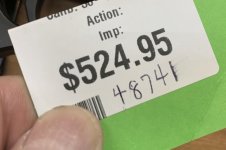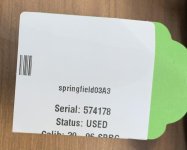sigp220.45
US Veteran
I only had a minute to check this one out. 1903 Springfield from Springfield Army, stock cut but metal is unmolested, 1942 barrel, 1914 manufacture.
It is under the magic number for “low number” Springfields, some of which had suspect heat-treating. Out of about a million, 90 or so cracked the receiver during firing.
I figure if this thing was gonna crack, it would have done so by now, and if Uncle Sugar was that worried about it he wouldn’t have rebarreled it for the 1941-1945 festivities.
I actually kind of like the stock the way it is, but I’ll probably look around for a correct one, so the cool kids will talk to me.
I haven’t bought it, but I’m considering it. I have a 1924 1903 already, but I could always use another.
Thoughts?
It is under the magic number for “low number” Springfields, some of which had suspect heat-treating. Out of about a million, 90 or so cracked the receiver during firing.
I figure if this thing was gonna crack, it would have done so by now, and if Uncle Sugar was that worried about it he wouldn’t have rebarreled it for the 1941-1945 festivities.
I actually kind of like the stock the way it is, but I’ll probably look around for a correct one, so the cool kids will talk to me.
I haven’t bought it, but I’m considering it. I have a 1924 1903 already, but I could always use another.
Thoughts?



